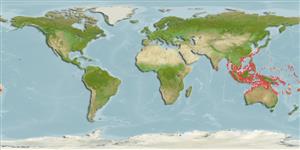Common names from other countries
>
Tetraodontiformes (Puffers and filefishes) >
Monacanthidae (Filefishes)
Etymology: Paramonacanthus: Greek, para = the side of + Greek, monos = one + Greek, akantha ) thorn (Ref. 45335).
Issue
This speces is valid according to several authors in CofF (ver. 11 May 2022).
Environment: milieu / climate zone / depth range / distribution range
Ekologi
laut berasosiasi dengan karang; oceanodromus (Ref. 51243); kisaran kedalaman 34 - 46 m (Ref. 33352). Tropical; 35°N - 31°N, 130°E - 141°E
Northwestern Pacific: confirmed from Japan.
Size / Weight / umur
Maturity: Lm ? range ? - ? cm
Max length : 12.0 cm SL jantan/; (Ref. 48637)
Duri punggung (Keseluruhan (total)) : 2; duri punggung lunak (Keseluruhan (total)) : 24 - 30; Duri dubur: 0; Sirip dubur lunak: 24 - 30; vertebrata, bertulang belakang: 19. body width 2.0-2.6 in head length; body depth 2.0-3.1 in SL, head length 2.7-3.2 in SL; snout length 3.7-4.1 in SL; eye diameter 2.7-3.7 in head length; second dorsalmost caudal ray elongate and filamentous in male (Ref. 33065).
Inhabits weedy and sandy areas of coastal reefs (Ref. 9710). Found on open muddy substrates from shallow estuaries to deep offshore. Males elongate with age (Ref. 48637). Monogamous (Ref. 52884).
Masuda, H., K. Amaoka, C. Araga, T. Uyeno and T. Yoshino, 1984. The fishes of the Japanese Archipelago. Vol. 1. Tokai University Press, Tokyo, Japan. 437 p. (text). (Ref. 559)
Status IUCN Red List (Ref. 130435)
CITES (Ref. 128078)
Not Evaluated
ancaman kepada manusia
Harmless
penggunaan manusia
Alat, peralatan
laporan khas
muat turun XML
Sumber internet
Estimates based on models
Preferred temperature (Ref.
115969): 24.6 - 28.4, mean 27.6 (based on 106 cells).
Phylogenetic diversity index (Ref.
82804): PD
50 = 0.5000 [Uniqueness, from 0.5 = low to 2.0 = high].
Bayesian length-weight: a=0.01862 (0.01139 - 0.03045), b=2.86 (2.72 - 3.00), in cm Total Length, based on LWR estimates for this species & (Sub)family-body (Ref.
93245).
Trophic level (Ref.
69278): 2.8 ±0.25 se; based on food items.
Daya lenting (Ref.
120179): sedang, Waktu penggandaan populasi minimum 1.4 - 4.4 tahun (Fec = 3,300).
Fishing Vulnerability (Ref.
59153): Low vulnerability (10 of 100).
